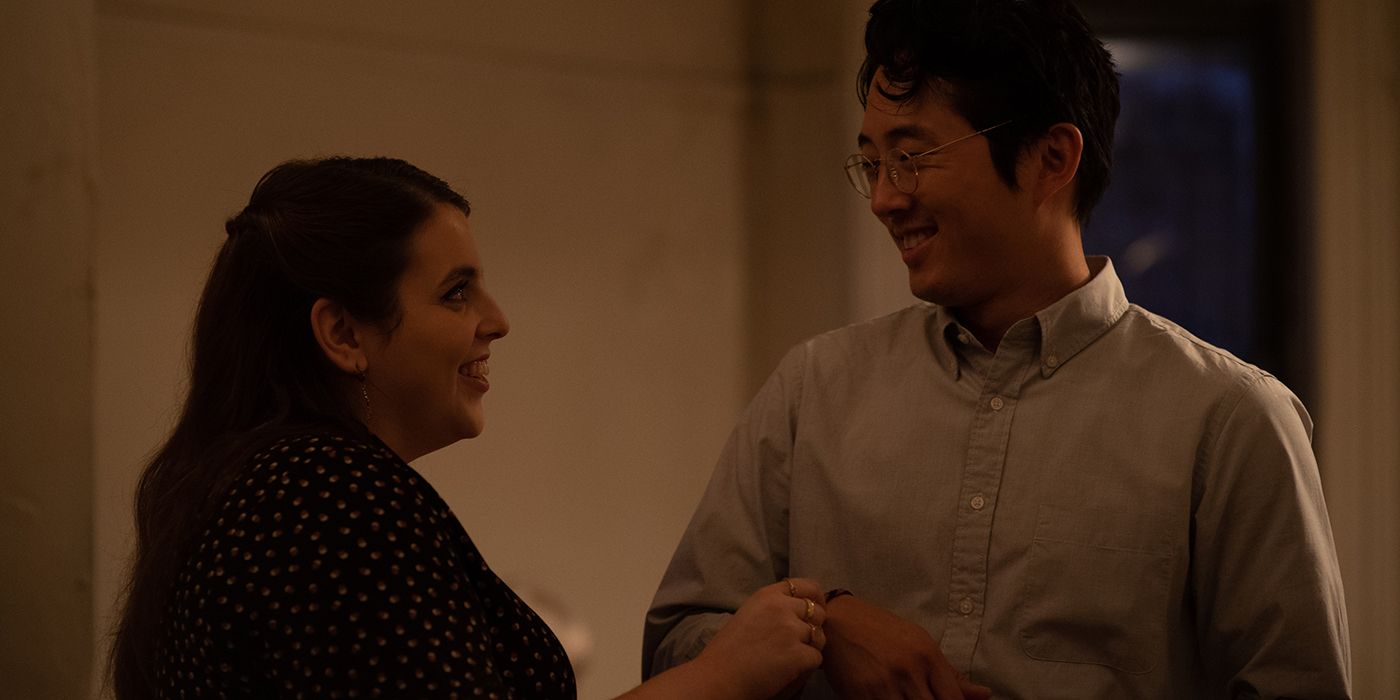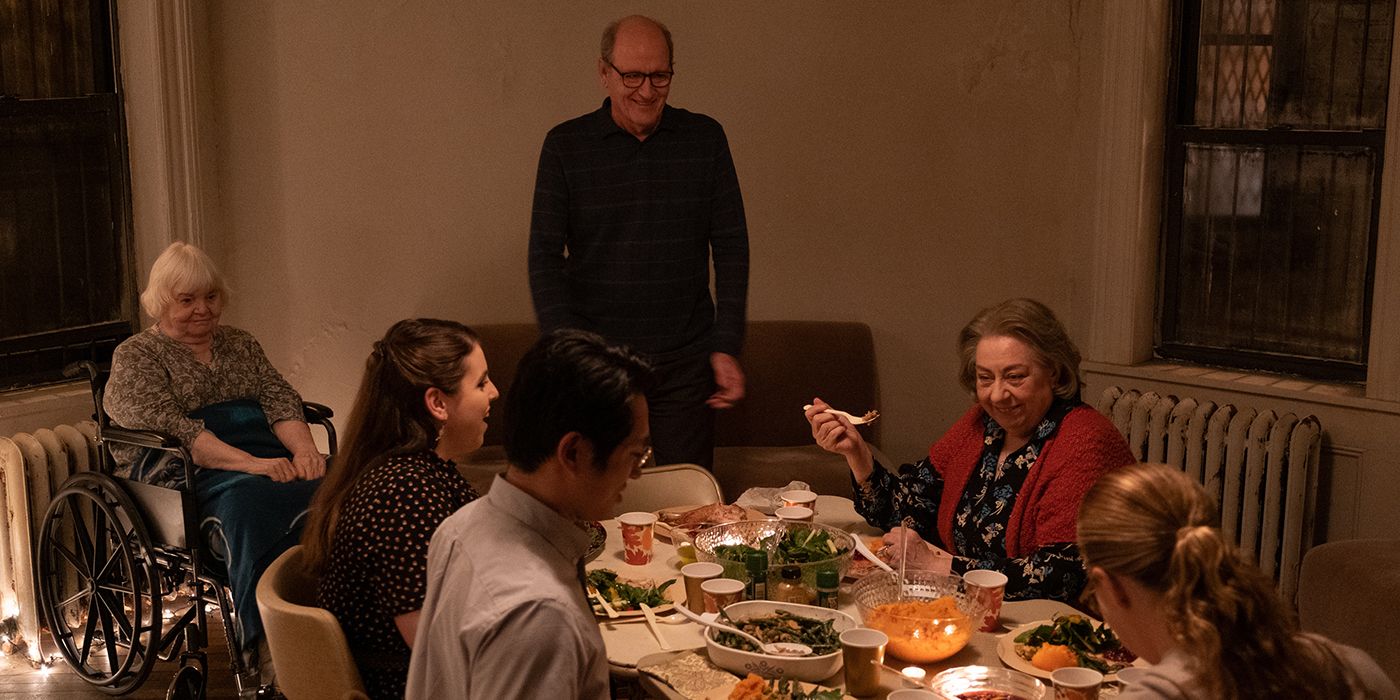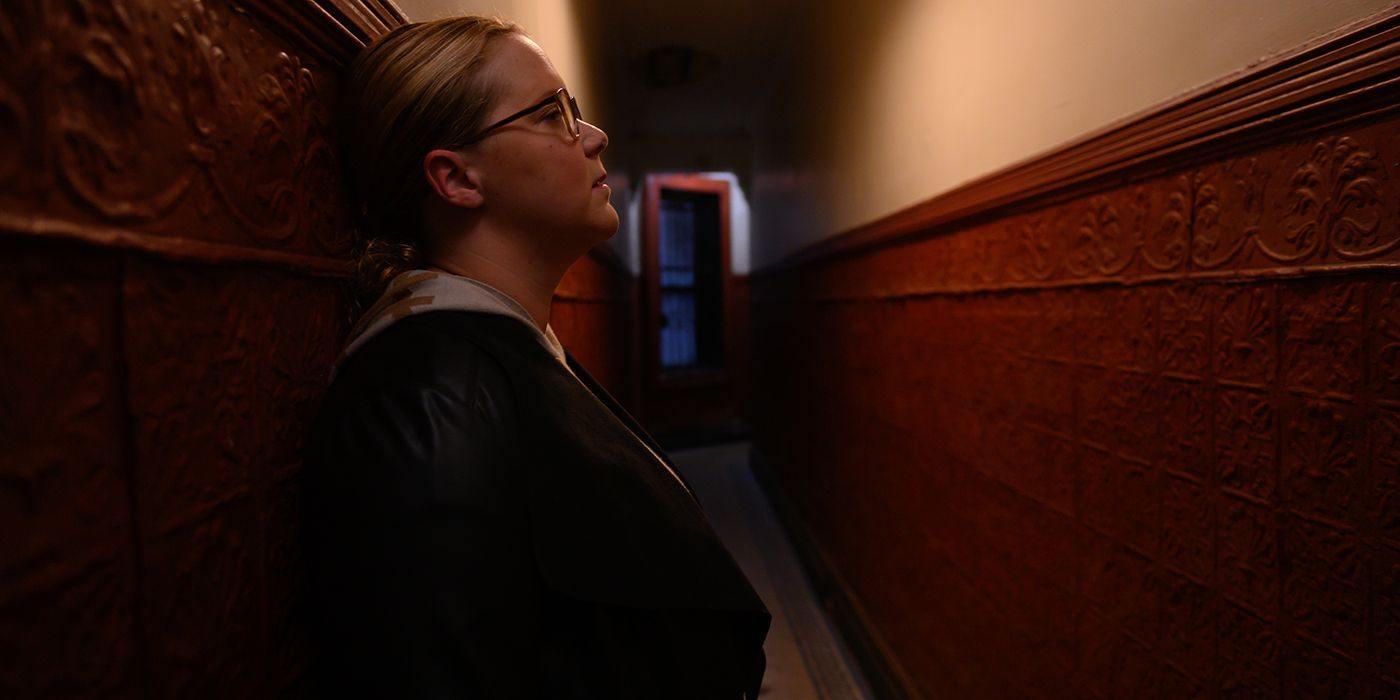The Humans, based on the Tony-award winning Broadway play of the same name, arrives in theaters and on Showtime November 24. The A24 film premieres just in time for Thanksgiving, which is fitting for a tale of an awkward and at times unsettling Thanksgiving dinner between a family that loves but doesn't always understand each other.
The Humans marks Stephen Karam's directorial debut, and he wrote the screenplay adaptation of his own stage play, but it is far from a straightforward reproduction. Instead, he guides the impressive cast - consisting of Richard Jenkins (The Shape of Water) and Jayne Houdyshell (who starred in the original production) as the patriarch and matriarch of the Blake family, June Squibb (Godmothered) as the ailing grandmother, Amy Schumer (I Feel Pretty) and Beanie Feldstein (American Crime Story) and daughters Aimee and Brigid, and Steven Yeun (Minari) as Brigid's live-in boyfriend Richard - through a unique meld of family drama and horror as the Blakes confront their fears and anxieties as a fractured unit.
Karam spoke to Screen Rant about the winding journey of adapting his own work for film, the joy of discovering exactly the right actors for the role, and his hope for a future in movies.
Screen Rant: The opening shot of The Humans was crazy.
Stephen Karam: It's from my actual old apartment. It was actually very hard to get. Eventually, it was me to the landlord, being like, "If we give you $200 and we don't bother anyone, can we please just shoot [outside]? We're literally going to film." They thought, "No, you're never actually going to the garbage area. You're gonna go break into an apartment." No, we literally just wanted to be in the garbage area.
As someone who has been creeped out by my own home, especially when I lived in a shoebox of an apartment in New York, it felt relatable to me. And I love that it's something that you could lean into when doing a film, as opposed to a play. At what point did you realize this has to be a movie as well?
Stephen Karam: It's a little bit of a winding road but let me try to do this somewhat directly. When I was even writing the play, it was very much inspired by a lot of cinematic tropes and psychological thrillers, because there's only so many stage thrillers that have worked. I found myself returning to Wait Until Dark and even film versions of stage thrillers and early Polanski. I grew up watching the Scream trilogy and Wes Craven, so those tropes were always in my head.
But really, it was after the Broadway run was dying down. I almost jokingly was like, "Well, this is so specifically applied. Let me just think about what it would actually mean to make it a movie." I was surprised by how clearly I saw it, how specifically I saw it, but also how the way to get at the soul and the heart of the story was just different. I never had that experience before; I always thought adaptation was about the pressure to preserve something that works in one genre. Can you just do the most polite adaptation possible so that you don't ruin anything? Of course, that's often how you ruin it. You end up with a middling adaptation that's like, "Why did they make this a movie?"
That sent me down the road of movies I love that were very interior, and that got me away from like, "Well, you can't make a movie and stay [inside]." It just became very clear to me from other filmmakers that I love that - like if you look at Vanya on 42nd Street, that feels open and more expansive than some movies with 100 locations. I startedpaying attention to the world, where the camera is, and how the camera's connected to the story and emotion, like with Who's Afraid of Virginia Woolf? - Nichols' first film. Edward Yang got me into a family very much seen through interior spaces and doorways and mirrors. It was a slow burn.
But I think it's because it was my first film. If I had been talking to friends who had more experience, I think I'd already probably assembled enough to be confident that I can make a movie. But when you haven't done something before, you're constantly battling your own fear. Really, the decision to plow full steam ahead was just to be okay with failure. I didn't want to do a safe adaptation, where a lot of people would be like, "I loved the play, and they made a somewhat boring and unsuccessful film adaptation."
I just decided to go the road that would probably result in, much like anything specific you do, maybe excite people or maybe you have a lot of people going, "I wish it was more like what I felt when I saw the play." But because my intentions were to translate the blood and the guts of the thing, it felt like the only way to do it was to do it differently. I just ran towards that, and I kept the budget very low. But I got to do it.
You mentioned the camera, and one thing I loved was how it felt like I was right there with the family. Did that require specific blocking, like you would have in a play, so you could map out the camera's role in rehearsal? Or did the actors have more freedom to explore the space?
Stephen Karam: What's interesting about independent film is it seems like there's two ways to go. One is everything is - in a good way - just a s**tshow, and you're improvisational because you're just showing up and you're like, "Where the hell are we? Let's figure out where to put the camera." But in this case, because it was an enclosed set for 99% of it, decisions were made based on this idea of being a voyeur. And then shots that would be mostly static, but when you move, you'd be a voyeur. The close-ups would develop as you'd be in the next room, and then you'd creep closer.
Developing these ideas of, like, dinner being a four, five, or six-shot of the table. But then when you're at the pig smash, you're in the room circling the table on a longer lens. It's almost like you know the family better; you've arrived, and you've gotten a seat at the table. You start with these ideas that get you so far, and then you see when you're making the movie which are the ones that feel right.
The ones that you're describing are some of the longer shots, tracking shots, or where it's just six actors spilling in and out of the frame. They totally required a lot of trust from the actors and a lot of blocking. And, of course, you don't have a lot of time. Really, the thing I can't believe worked out was how wonderful they were. I made the right move in really getting them on board with the concept. Because I hadn't done it before, I didn't realize how critical it is to have the right actors. I could have had those ideas, but not had the right people.
Instead, not only are they fully in their bodies and listening to each other in those moments, but all six of them had to be good at the same time for 2 to 4 minutes at a time. That circling shot at the table is an eight-and-a-half-minute continuous shot. I absolutely loved that they're so good that you're not thinking, "Wow, it's been 45 seconds, and all of them have been behaving like good actors." Hopefully, you're just in the room observing them.
The opening of the film was almost built to teach you how to watch the film, like the shot where they're getting June Squibb into the wheelchair. You have this feeling that it's more of a slow burn. "Why aren't they cutting away? Oh my God, they're really gonna keep going. Now they have to make a three-point turn to get her." It's also telling people that these things will happen, and this will be part of the way you get to experience it. There's no dialogue, but you're going to learn about their 40-year marriage and the state of his mom and her health.
In the play, where there's paragraphs about Momo's condition, I was like, "What if we just show how hard it is to get an older woman into a wheelchair out of the bathroom down the hallway in a pre-war apartment?" The things that I really gravitated towards, to your point, really did require a lot of coordination and planning.
The actors are all fabulous, and I love the range. You have Jayne, who has lived with this play almost as long as you have. And on the other hand, I don't think many would expect Amy Schumer to be in a role or film like this, yet she nails it. How did you amass this particular collection of actors?
Stephen Karam: First of all, I thought they would all be right. That's the easiest answer: there was a gut level feeling of, "I think these are the people."
Part 2 of that is I do think an ensemble piece like this that is written in such a specific way - if you read the screenplay, it so is what it is - also attracts the right kind of actors. The type of actor who's as famous as Amy, who might be interested in a role like this for the wrong reasons, probably ultimately wouldn't even want to be considered for it. Because it's just very clearly not going to be "all eyes on me" all the time. The script is so clear about that, but she was like, "I want to do this." That's almost a good sign in and of itself. So much of her stuff is non-verbal. She's in the bathroom, you're looking at Instagram through her glasses, you know? "Instagram Through Glasses" should be the alternate title.
A project like this sort of announces itself as so clearly what it is. And I think I was pleasantly surprised by the actors I got, talent-wise and just special energy-wise. Steven was coming off Burning and shooting Minari; he finished it before we did this. Him just wanting to do it was [great]. I think each one of them looms large to me as a star, and each one of them can carry their own film easily, and have. With the exception of Jayne, because this is our first leading role. But Jayne looms large for me as a star because of my knowledge of her talents and her stage history.
There's something to their attraction to it that answers your question. The fact that Amy wanted to be part of an ensemble is part of why I think she was able to disappear. She just got it. She knew the piece wasn't about her pulling focus at every moment. And the genius thing about actors who listen as brilliantly as these six do is that they all become better. Their generosity yields fruit. They're there for each other, but they're all lifted up as a result of it. Her performance in particular.
For people who don't know, when we first met, it was just very clear to me that, "Oh, you are in fact an actor." Even being a first-time director: when you're in a lane and people say, "But you're a journalist. You're a playwright." For you, "Well, you write about film," as if you can never, 10 years from now, decide to specialize in something else. But everything she said about her understanding of the character and her part in this family made me think it was really just gonna come down to if she would show up to set. Because it was very clear that she got even the sister relationship with Beanie [Feldstein].
And that's the same for all of them. None of them were like, "Wait, why do these people from Scranton behave this way? Why are they doing that?" I had that magic experience where the actors that we cast were also the ones that were right for it. I think if we went to six equally talented actors who would have been wrong for it, they probably would have just said like, "I'm not doing this. I gotta listen to five other people for the movie. This is terrible. Where are my close-ups?"
Are you planning on doing more films after the critical acclaim of The Humans, or do you want to return to theater?
Stephen Karam: No, I would love to make more movies. If anything, it's given me the excitement to - instead of just adapt something - finally do the thing that I've always wanted to do: write a screenplay specifically that I'm going to direct.
The Humans arrives in theaters and air on Showtime starting November 24.



